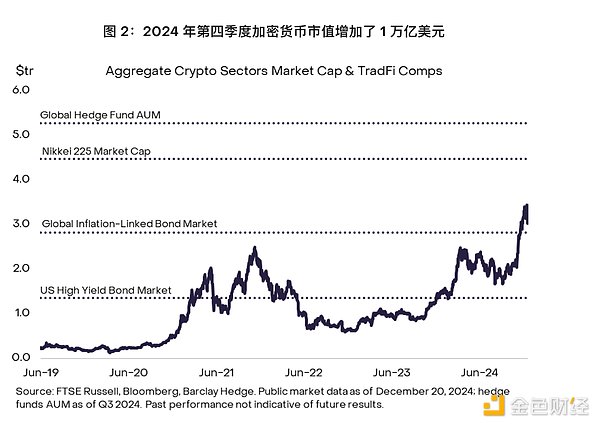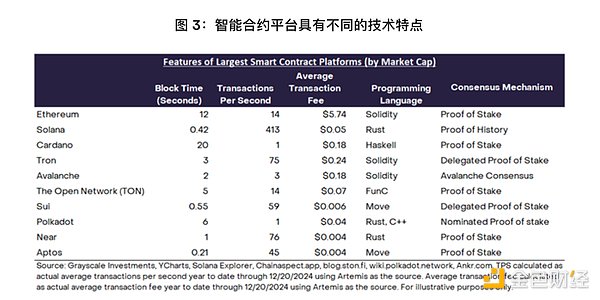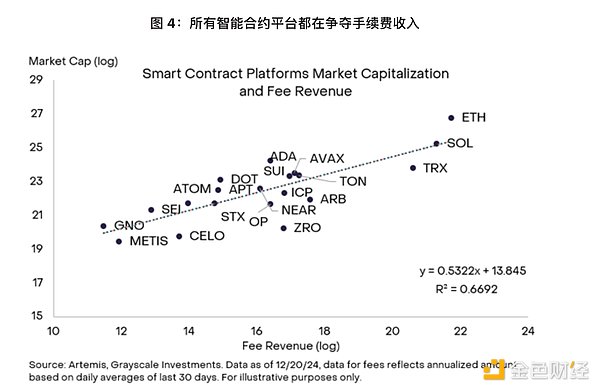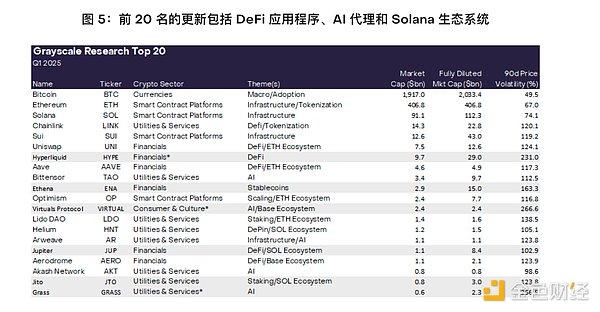Author: Grayscale Source: Grayscale Research Translation: Shan Ouba, Golden Finance
The crypto market surged in the fourth quarter of 2024, a trend that can be confirmed by the FTSE/Grayscale Crypto Industry Index family. The market's rise mainly reflects the positive reaction to the results of the US election.
Smart contract platforms are highly competitive, and although Ethereum is still the leader in the field, its performance is not as good as Solana, the second largest in market value. At the same time, investors are increasingly paying attention to other alternative Layer 1 networks, such as Sui and The Open Network (TON).
The Grayscale Research team has updated the Top 20 Assets list, which covers a diverse range of assets in various crypto industry sectors that we believe have high potential in the next quarter. Newly added assets this quarter include HYPE, ENA, VIRTUAL, JUP, JTO, and GRASS. It should be noted that these assets have large price fluctuations and high investment risks.
The Grayscale Crypto Industry Index System provides a comprehensive framework to help understand investable digital assets and the technical principles behind them. Based on this framework, Grayscale has developed the FTSE Grayscale Crypto Industry Index Series in collaboration with FTSE Russell to measure and monitor crypto asset classes. Grayscale Research incorporates these indices into its ongoing analysis of the digital asset market.

The crypto market valuation surged in the fourth quarter of 2024, mainly due to the positive market reaction to the results of the US election. According to the Composite Crypto Market Index (CSMI), the total market value of the crypto industry grew from US$1 trillion to US$3 trillion in the quarter.
Comparing the crypto market capitalization with traditional public and private market asset classes, the current market size of the digital asset industry is comparable to the global inflation-linked bond market and more than twice the size of the U.S. high-yield bond market, but still significantly smaller than the global hedge fund industry or the Japanese stock market.

As market valuations rise, many new tokens meet the inclusion criteria of the crypto industry framework (most assets have a minimum market value requirement of $100 million). During this quarter’s rebalancing, we added 63 new assets to our index family, which now includes 283 tokens. The Consumer & Cultural Crypto sector saw the most new additions, reflecting continued strong returns for memecoin and appreciation for gaming and social media-related assets. The largest new asset by market cap this quarter was Ethereum Layer 2 protocol Mantle, which now meets our minimum liquidity requirements. Smart Contract Platforms are perhaps the most competitive market segment in the digital asset industry. While 2024 is a big year for Ethereum, with the company receiving U.S. spot exchange-traded product (ETP) approval and completing a major upgrade, Ether (ETH) has underperformed competitors like Solana.
Investors are also looking at other Layer 1 networks, including the high-performance blockchain Sui and the TON blockchain integrated with Telegram.
When it comes to building infrastructure for application developers, designers of smart contract blockchains face a variety of design choices that affect the "blockchain trilemma": network scalability, security, and decentralization. For example, blockchains that prioritize scalability often exhibit high throughput and low transaction fees (such as Solana), while blockchains that prioritize decentralization and security may have lower throughput and higher fees (such as Ethereum).

Regardless of the design, the value of a smart contract platform comes primarily from its ability to generate network fee income. Fee income is often seen as the main driver of the value of blockchain tokens in this market, although indicators such as total locked volume (TVL) are equally important. Data shows that there is a significant statistical relationship between fee income and platform market value.
The following smart contract platforms are included in the Grayscale Research Top 20 this quarter:
• Ethereum (ETH)
• Solana (SOL)
• Sui (SUI)
• Optimism (OP)

Grayscale Research Top 20 Asset List
Every quarter, the Grayscale Research team analyzes hundreds of digital assets to guide the rebalancing process of the FTSE/Grayscale Crypto Industry Index family. Subsequently, we will release a list of the top 20 assets in the crypto industry that have high potential in the next quarter.
This quarter, we pay special attention to the following three market themes:
1. The US election and its potential impact on regulation in areas such as DeFi and staking;
2. Continued breakthroughs in decentralized AI technology and the trend of AI agents using blockchain;
3. The continued growth of the Solana ecosystem.
Against this backdrop, the six new assets added this quarter include:
• Hyperliquid (HYPE): A Layer 1 blockchain focused on supporting on-chain financial applications, with the main application being a fully on-chain perpetual contract decentralized exchange (DEX).
• Ethena (ENA): Ethena has launched a new stablecoin called USDe, which is primarily backed by hedged positions in Bitcoin and Ethereum.
• Virtual Protocol (VIRTUAL): A protocol for building AI agents on Ethereum’s Layer 2 network Base, allowing the creation and co-ownership of tokenized AI agents.
• Jupiter (JUP): The largest DEX aggregator on Solana, with the highest TVL among all Solana applications.
• Jito(JTO): A liquidity staking protocol on Solana that generated over $550 million in fee income in 2024.
• Grass(GRASS): A decentralized data network that allows users to share idle bandwidth through a Chrome extension, which is sold to AI companies for training machine learning models.
These assets represent the most growth-potential and innovative sectors in the crypto industry, providing investors with diversified options.

Note: Shading indicates new additions to the upcoming quarter (Q1 2025). *Asterisks indicate sectors to which assets not included in the Crypto Industry Index belong. Source: Artemis, Grayscale Investments. Data as of December 20, 2024. For illustrative purposes only. Assets are subject to change. Grayscale, its affiliates, and clients may hold positions in the digital assets discussed here. All assets in our top 20 list have high price volatility and should be considered high risk.
In addition to the new themes mentioned above, we remain confident in the areas we have focused on in previous quarters, such as Ethereum scaling solutions, asset tokenization, and decentralized physical infrastructure (DePIN). These themes are also reflected in this quarter's Top 20, including the continued inclusion of protocols such as Optimism, Chainlink, and Helium, representing the leading positions in these tracks.
This quarter, we removed projects such as Celo from the Top 20. Although the Grayscale Research team still recognizes the value of these projects and believes that they are still an important part of the crypto ecosystem, we believe that the adjusted Top 20 asset portfolio may provide a more attractive risk-return ratio in the coming quarter.
There are risks in investing in crypto asset classes, some of which are unique to crypto assets, including smart contract vulnerabilities and regulatory uncertainty. In addition, all assets in our Top 20 list are highly volatile and high-risk and are not suitable for all investors. Therefore, when considering investing in digital assets, investors should fully assess the potential risks in light of their own portfolio and financial objectives.
Index Definition:
The FTSE/Grayscale Crypto Industry Index (CSMI) measures the price returns of digital assets listed on major global exchanges.
Notes:
[1] As of December 20, 2024, the Crypto Sectors Total Market Index rose 58% this quarter. Data source: FTSE, Grayscale Investments.
[2] Data source: FTSE, Grayscale Investments, as of December 20, 2024.
[3] Data source: FTSE Russell, as of December 20, 2024.
[4] Data as of December 20, 2024.
[5] USDe collateral may include other liquid stablecoins.
[6] Bitget.
 Kikyo
Kikyo
 Kikyo
Kikyo Joy
Joy Catherine
Catherine Aaron
Aaron Hui Xin
Hui Xin Alex
Alex Snake
Snake YouQuan
YouQuan Jasper
Jasper Jasper
Jasper